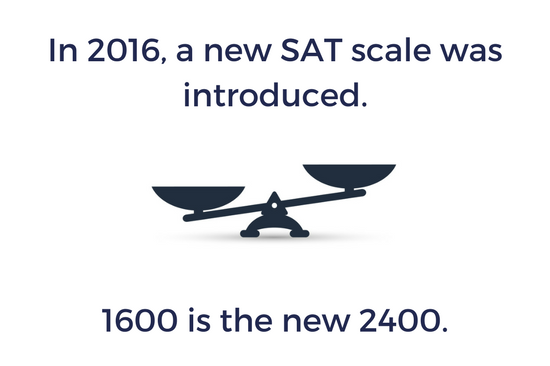A good SAT score can hold a lot of weight when it comes time to apply to universities, so it's important to understand how the test is scored, what a good score is for you, what score you'll need to get into different schools, and how to improve your score if it's not quite where you want it to be.
While it's mostly true that no one cares about your SAT score after college, they certainly care about it before you get in.
Well, at least admissions officers do.
Your SAT score is just one part of your application, but it plays a big role as it allows admissions officers to quickly and objectively compare you to the rest of the applicants, of which there are usually tens of thousands. Plus, as most schools publish the average SAT score of their admits on their website, having a student body with a high SAT average reflects well on their admissions standards.
Do you have a good SAT score right now, or is there room for improvement? Will your current SAT score get you where you want to go? And if you need to improve your score, where do you begin?
The new SAT scale

Before you prepare for the SAT, you should know about the new scoring scale, which was released in 2016. Now, it only goes up to 1600 (rather than the previous 2400) as the old Reading and Writing sections have been combined into one. Just like before, each section is worth 800 points — but now, the only two sections are "Evidence-Based Reading & Writing" and "Mathematics."
How is the SAT scored?
After the new scoring scale was introduced, but before College Board (which administers the SAT) announced it will eliminate the SAT Essay and Subject Tests by the end of this year, there were three components considered within the 1600-point scale: the “Reading & Writing” and “Mathematics” sections mentioned above, as well as an optional essay. However, with the essay being phased out, SAT scores will now consist of just the individual scores for both sections, which are combined to form your composite score.
For each section, the score range is 200 to 800, with 400 to 1600 being the score range for the entire test. So, before you get your scores back, remember these numbers:
- 1600 is the new perfect score to aim for.
- There are only two sections.
- There's no way to get a score of 0.
What is considered a good SAT score’
According to data published in College Board’s 2020 SAT Annual Report, among the 2.2 million 2020 high school graduates who took the test, the average SAT composite score was 1051, with the average “Reading & Writing” score being 528 and the average “Mathematics” score is 523.
Once you know what the average SAT score is, you can deduce that any score higher than 1051 is an above-average score and any score below 1051 is a below-average score. Simple enough, right?
Not quite. There are two factors that can help you determine whether or not you have a good SAT score:
- SAT Percentiles
- University Average SAT Score
SAT Percentiles
Percentiles reveal how well you did on your exam in comparison to everyone else who took the exam on the same day. For example, if you’re in the 15th percentile, you did better than 15% of the students who took the exam that day. If you’re in the 90th percentile, you did better than 90% of the students and so on.
If you are in the 15th percentile, you are well below average – 85% of students did better than you. Generally speaking, anything below the 50th percentile is considered ‘bad’; anything in the 50th-70th percentile is ‘good’, and anything above the 90th percentile is great!
Check out the chart below to see what SAT scores line up with which percentiles. Keep in mind that these percentiles may change slightly depending on when you take the exam.
SAT Composite Score vs. Percentile Score
| SAT Composite Score | Percentile Score |
|---|---|
| 1550-1600 | 99-99+% |
| 1500-1550 | 98-99% |
| 1450-1500 | 96-98% |
| 1400-1450 | 94-96% |
| 1350-1400 | 90-94% |
| 1300-1350 | 86-90% |
| 1250-1300 | 81-86% |
| 1200-1250 | 74-81% |
| 1150-1200 | 67-74% |
| 1100-1150 | 59-67% |
| 1050-1100 | 50-59% |
| 1000-1050 | 41-50% |
| 950-1000 | 33-41% |
| 900-950 | 25-33% |
| 850-900 | 18-25% |
| 800-850 | 11-18% |
| 750-800 | 6-11% |
| 700-750 | 3-6% |
| 650-700 | 1-3% |
| 600-650 or lower | 1% or lower |
University average SAT scores
Although less objective, the best way to define whether or not you have a good SAT score is knowing whether or not it aligns with the standards of the universities you’re applying to. The SAT score range you should be aiming for depends on which college you want to go to! In general, the more highly ranked a school is, the better SAT scores you'll need to get accepted there.
It’s worth noting that due to ongoing COVID-19 restrictions, many colleges and universities in the US have opted to make standardized test scores optional for applicants to the class of 2026. However, many of the most prestigious schools in the nation have decidedly stated that they do not plan to adopt permanent test-optional policies — and with a good SAT score, you can still boost your application above the competition. Test-optional policies indicate that applicants will not be judged on the absence of test scores, but their presence will still be taken into account.
To help you understand what SAT scores are required for the top 20 universities in the US, we’ve compiled a list of the average SAT scores of their accepted students.
US Top 20 Universities Average SAT Scores
| University | Average Composite SAT Score |
|---|---|
| Princeton University | 1505 |
| Harvard University | 1520 |
| Columbia University | 1505 |
| Massachusetts Institute of Technology | 1535 |
| Yale University | 1515 |
| Stanford University | 1505 |
| University of Chicago | 1520 |
| University of Pennsylvania | 1500 |
| California Institute of Technology | 1545 |
| Johns Hopkins University | 1505 |
| Northwestern University | 1495 |
| Duke University | 1510 |
| Dartmouth College | 1500 |
| Brown University | 1485 |
| Vanderbilt University | 1505 |
| Rice University | 1505 |
| Washington University | 1520 |
| Cornell University | 1480 |
| University of Notre Dame | 1475 |
| University of California, Los Angeles | 1405 |
So, overall — what's a good SAT score? It depends.
For the Ivy League, it's about 1500-1550. For other highly competitive schools, it's above 1400. And for most other colleges, 1300 and above will make you a competitive applicant.
How to improve your SAT score
Now that you know roughly what SAT score to aim for, you may be wondering how to get there.
Here are a few resources to get you started:
And here are some steps to take in the right direction:
1. Study harder and re-sit the exam
Luckily, you can take the SAT as many times as you’d like (although try to keep it under three, as anything more isn’t a great look on your application)!
However, simply sitting the exam over and over again won’t improve your score. In order to actually make a change, you’ll need to improve your study habits, come up with a proper SAT prep plan and perhaps even get some tutoring!
Pro tip: Some colleges will ‘superscore’ your SAT.
A superscore is a combination of your highest score on each section across every SAT you take. Therefore, instead of using your scores from only one date, certain schools combine your highest section score across all dates and create your highest possible composite score!
2. Re-evaluate your university list
If re-taking the SAT after planning, studying and tutoring still doesn’t get you close to the score you’ll need to compete at your target schools, it’s a good indication that those schools may not be the best fit for you. Ultra-competitive universities accept applicants with near-perfect SAT scores because those applicants have demonstrated their eagerness to take on highly demanding and rigorous coursework. In general (though this certainly doesn’t apply to every student), if the SAT score for your dream school’s average is far out of reach, their academics may also be too difficult and demanding for you to get the most out of studying there. And that’s okay! Your college experience is the sum of many parts, only one of which is the classwork.
3. Stay optimistic and on track
On the flip side, don’t be discouraged if you don’t quite get the score you need to get into your dream uni. If you’re off by a relatively small margin, you can make up for a lower SAT score by having incredible grades, writing fantastic essays and getting involved in unique extracurricular activities! Thanks to the holistic US application system, admissions officers will often look past sub-par test scores if the rest of the application shines.
